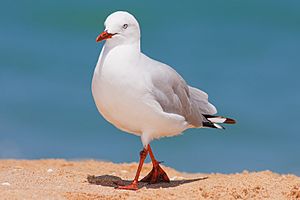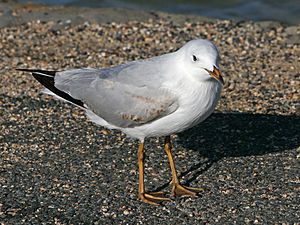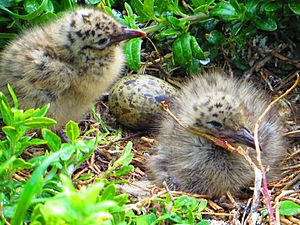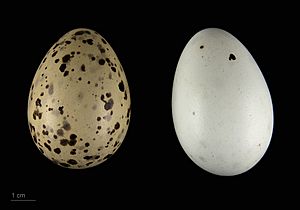Silver gull facts for kids
Quick facts for kids Silver gull |
|
|---|---|
 |
|
| Adult | |
| Conservation status | |
| Scientific classification | |
| Genus: |
Chroicocephalus
|
| Species: |
novaehollandiae
|
| Subspecies | |
|
C. n. forsteri (Mathews, 1912) |
|
The silver gull (Chroicocephalus novaehollandiae) is a very common type of gull found in Australia. You can see them almost everywhere on the continent. They especially like to live near the coast.
Silver gulls are smaller than another Australian gull called the Pacific gull. It's good to know that the silver gull is not the same as the "herring gull" found in Europe. The European herring gull is much bigger and lives in different parts of the world.
Contents
About Silver Gulls
Scientists group animals into different families. The silver gull used to be in a group called Larus. Now, it's usually placed in the Chroicocephalus group.
There are three main types, or subspecies, of silver gulls:
- C. n. forsteri: These gulls live in northern and northeastern Australia. You can also find them in New Caledonia and the Loyalty Islands.
- C. n. novaehollandiae: This type lives in southern Australia and Tasmania.
- C. n. scopulinus: This one is also called the red-billed gull. It lives in New Zealand.
What Do They Look Like?
Silver gulls have white heads, bodies, and tails. Their wings are light grey. The tips of their wings are black with white spots.
Adult gulls are about 40 to 45 centimeters long. Their wings can spread out to about 94 centimeters wide. Young gulls have brown patterns on their wings. They also have dark beaks. As they get older, their beaks turn bright red. The brighter the red, the older the bird is!
Where Do They Live?
Silver gulls live in all parts of Australia. They also live in New Zealand and New Caledonia. They are very common birds.
These gulls have learned to live well in cities. They often hang around shopping centers and garbage dumps. Because they are so good at living near people, their numbers have grown a lot. The only thing that stops them from growing even more is finding enough places to build their nests.
How Do They Behave?
Silver gulls have a loud voice. They make many different sounds. Their most common call is a harsh, high-pitched 'kwarwh'.
What Do They Eat?
In nature, silver gulls eat worms, fish, insects, and crabs. They are also very good at finding food left by humans. This is why you see so many of them near towns and cities.
Reproduction and Life Cycle
Silver gulls usually lay eggs between August and December. They often nest in large groups on islands away from the coast. Their nests are built on the ground. They use seaweed, roots, and plant stems to make them. You might find nests in small bushes, on rocks, or on jetties.
A female gull usually lays one to three eggs. They often have two sets of babies in one year. Both the mother and father gulls help build the nest. They also take turns sitting on the eggs to keep them warm. After the eggs hatch, both parents help feed the baby gulls.
Gallery
-
A silver gull at Ku-ring-gai Chase National Park, Sydney
-
A silver gull at Circular Quay railway station, Sydney
See also
 In Spanish: Gaviota plateada para niños
In Spanish: Gaviota plateada para niños











